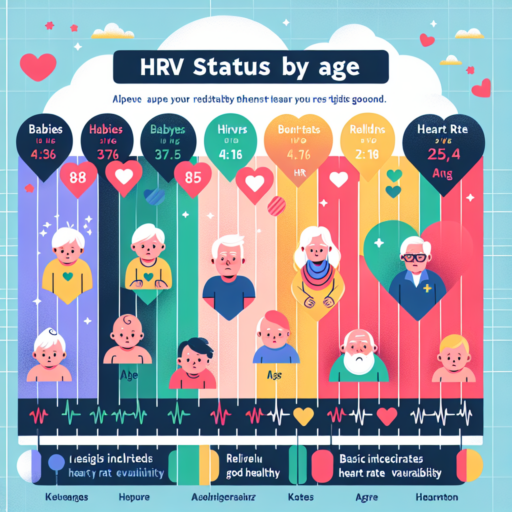What Is HRV and Why Does It Matter
Heart Rate Variability (HRV) is a measure of the variance in time between each heartbeat. Contrary to what some might think, a healthy heart does not beat with the regularity of a metronome; instead, there are slight variations in the time between each heartbeat. These variations are considered a representation of the body’s autonomic nervous system (ANS) activity, and understanding them can provide deep insights into our overall health and resilience.
HRV is an important metric because it is an indicator of our body’s ability to manage stress. A higher HRV suggests that the body is better equipped to handle stress and adapt to changing situations, while a lower HRV is often a signal that the body is experiencing stress or may not be recovering properly. It is a non-invasive way to monitor the balance between the sympathetic (fight or flight) and parasympathetic (rest and digest) nervous systems, giving us an overview of our stress levels and recovery status.
In the context of health and wellness, understanding and monitoring HRV can be a crucial element for athletes, individuals managing stress, or anyone interested in optimizing their health. By tracking HRV, people can make informed decisions about their lifestyle, exercise, and recovery activities to improve or maintain their health and wellbeing. Therefore, HRV matters a lot in the realms of fitness, stress management, and personal health optimization.
The Basics of Understanding HRV Status
Heart rate variability (HRV) offers insightful data about our overall well-being, stress levels, and cardiovascular health. Understanding HRV is pivotal for athletes, fitness enthusiasts, and anyone interested in maintaining an optimal health status. It reflects the variation in time between each heartbeat, which is directly linked to our body’s autonomic nervous system (ANS). This system regulates unconscious processes such as heart rate, respiratory rate, and digestion.
Factors Influencing HRV: Various elements can affect your HRV status, including physical activity, stress, sleep quality, and lifestyle choices. For instance, a high HRV indicates a healthy, responsive cardiovascular system able to adapt to stresses and changes in the environment effectively. Conversely, lower HRV scores may suggest stress, overtraining, or potential underlying health issues. Monitoring changes in HRV over time can help in identifying patterns and making informed decisions about health and fitness routines.
Monitoring Tools and Techniques
To accurately measure HRV, several tools and techniques are available, ranging from wearable devices like smartwatches and fitness trackers to specialized medical equipment. These devices primarily use photoplethysmography (PPG) or electrocardiography (ECG) to record heartbeats and calculate HRV. Regular monitoring can provide valuable insights into how different activities and lifestyle changes affect your HRV and, by extension, your overall health.
How Age Affects Your Heart Rate Variability (HRV)
Understanding how age impacts Heart Rate Variability (HRV) is crucial for recognizing the shifts that occur in our cardiovascular system over time. HRV, the measure of variation in time between each heartbeat, is often viewed as a strong indicator of heart health and overall wellness. As we age, our bodies undergo significant changes that can influence the efficiency and functionality of various systems, including the heart.
One of the primary effects of aging on HRV is a general decline in its values. Scientific studies suggest that with advancing age, the body’s sympathetic nervous system becomes more dominant. This results in a less flexible heart rate, thereby reducing HRV. Additionally, the aging process can lead to alterations in the heart’s structure and function, further impacting HRV readings. This is particularly evident during physical activity or stress, where an older individual’s heart may not respond as variably as a younger person’s.
Moreover, the decrease in HRV as part of aging underscores the importance of cardiovascular fitness. Engaging in regular physical activity can help mitigate some age-related declines in HRV, promoting heart health and longevity. Furthermore, lifestyle factors such as diet, stress management, and sleep quality play significant roles in maintaining optimal HRV levels throughout one’s life.
No se han encontrado productos.
Optimal HRV Ranges for Different Ages
Understanding the optimal Heart Rate Variability (HRv) ranges for different age groups is essential for monitoring and maintaining cardiovascular health. HRV measures the variation in time between each heartbeat, reflecting the heart’s ability to respond to varying stress levels and demands. Below, we delve into what these ranges generally look like across various ages, providing a guideline for what can be considered healthy and normal.
Children and Adolescents
In younger individuals, particularly children and adolescents, HRV tends to be higher, indicating a robust and highly adaptable autonomic nervous system. During these years, typical HRV values can range widely, often between 50 and 100 milliseconds (ms) due to their bodies’ rapid growth and constant changes. It’s crucial for parents and guardians to understand that variability is a sign of healthy heart function during these developmental stages.
Adults
As individuals transition into adulthood, the average HRV starts to stabilize but generally remains in a healthy range of 20 to 50 ms. This variation signifies a well-balanced nervous system where stress and relaxation responses are in equilibrium. For adults, maintaining an HRV within this range can contribute to better stress management, emotional resilience, and overall cardiovascular health.
Seniors
In the senior years, HRV can decline, reflecting the natural aging process of the cardiovascular system. Average values for this age group often fall below 20 ms, however, it’s critical to recognize that lower HRV scores do not necessarily indicate poor health. Seniors with lower but stable HRV readings can still exhibit strong cardiac and nervous system functionality. Regular monitoring in this age group is essential for detecting any significant changes that could indicate health issues.
Improving Your HRV Status as You Age: Tips and Strategies
Understanding and maintaining a healthy Heart Rate Variability (HRV) is crucial for aging well. HRV measures the variation in time between each heartbeat, reflecting your heart’s ability to respond to different stress levels and environmental demands. A higher HRV indicates better cardiovascular health, stress resilience, and overall wellness. As we age, our HRV can naturally decrease. However, adopting specific lifestyle changes and strategies can help improve your HRV status over time.
Engage in Regular Physical Activity
One of the most effective ways to enhance your HRV is through regular physical activity. Exercise, especially aerobic activities like walking, cycling, and swimming, has been shown to significantly improve heart health and increase HRV. Incorporating a balanced mix of cardio, strength training, and flexibility exercises into your weekly routine can optimize your cardiovascular system’s efficiency and adaptability.
Practice Stress Management Techniques
Chronic stress can take a toll on your HRV, leading to a lower score and increased health risks. Implementing stress management techniques such as meditation, deep breathing, or yoga can help mitigate the adverse effects of stress on your HRV. Regular practice of these activities encourages a state of relaxation and equilibrium in the body, fostering an environment where your HRV can improve.
Adopting these strategies not only supports your HRV but also contributes to a healthier lifestyle as you age. By focusing on physical activity and stress management, you can work towards enhancing your cardiovascular health and resilience, paving the way for a vibrant and healthy aging process.
The Relationship Between HRV, Age, and Overall Health
The fascinating interplay between Heart Rate Variability (HRV), age, and overall health is gaining increased attention within the medical and wellness communities. HRV, a measure of the variation in time between each heartbeat, is considered a key indicator of autonomic nervous system function and, hence, an individual’s stress resilience and physiological adaptability. As we age, our bodies undergo various changes that can influence HRV and, by extension, our overall health status.
Impact of Age on HRV
Research suggests that HRV tends to decrease with age, a factor that is associated with a decline in autonomic nervous system plasticity. This decline in HRV as one grows older reflects changes in the balance between the sympathetic and parasympathetic branches of the nervous system. The result? An aged body might be less capable of responding to stress, recovering from exercise, or managing various health challenges – all of which are critical for maintaining optimal health.
HRV: A Mirror Reflecting Overall Health?
HRV does not only change with age; it is also influenced by a host of lifestyle factors, including physical activity levels, stress, sleep quality, and diet. Consequently, a low HRV can sometimes signal underlying health issues or a higher risk of future health problems. Conversely, maintaining or improving HRV through lifestyle modifications indicates not just resilience to stress but also a robustness in overall health. Regular monitoring of HRV, therefore, can provide valuable insights into one’s physiological well-being, serving as both a predictor and a motivator for healthy aging.
Monitoring HRV over Time: What You Need to Know
Monitoring your Heart Rate Variability (HRV) over time can provide profound insights into your overall wellness, stress levels, and cardiovascular health. It’s a vital metric that reveals how well your body can adapt to stress, both physical and emotional. Instead of focusing solely on the heart rate, which tells you how many times your heart beats per minute, HRV looks at the exact intervals between your heartbeats, yielding a much more nuanced understanding of your heart’s functioning and resilience.
Understanding the Significance of HRV
HRV is a bellwether for autonomic nervous system balance and flexibility. A higher HRV indicates better cardiovascular fitness, stress resilience, and overall health. Conversely, a lower HRV can signal stress, fatigue, or underlying health issues. Continuous monitoring of HRV allows individuals to assess how their lifestyle—be it diet, exercise, or stress management practices—affects their body on a day-to-day basis. These insights can guide you to make healthier choices and understand the efficacy of your wellness routines on a deeper level.
How to Monitor HRV Effectively
- Consistency Is Key: For accurate HRV measurements, it’s imperative to measure your HRV at the same time each day, preferably in the morning, to minimize variables that could affect its readings.
- Use the Right Tools: Reliable HRV measurement requires the use of a chest strap monitor or a high-quality wearable device designed to track HRV specifically. These tools can provide you with precise readings.
- Track and Analyze: Regularly logging your HRV readings alongside notes on your daily activities, stress levels, and sleep quality can help identify patterns and lifestyle factors that influence your HRV.
By keeping a close eye on HRV and understanding its fluctuations, you can gain valuable insights into how different aspects of your lifestyle affect your autonomic nervous system and overall health. This ongoing monitoring is a cornerstone in personal health management and optimization.
Using Technology to Track Your HRV Status by Age
Heart Rate Variability (HRV) is a critical indicator of your body’s stress levels, recovery status, and overall heart health. As we age, monitoring our HRV can provide invaluable insights into how our bodies respond to stress, exercise, and rest. Thanks to technological advancements, tracking your HRV status has never been easier, regardless of your age. Understanding the changes in HRV as you age can thus empower you to make timely adjustments to your lifestyle, enhancing your health and well-being.
Choosing the Right HRV Monitoring Technology
With a plethora of HRV tracking devices and apps available in the market, selecting the right technology is crucial for accurate and useful data. Devices such as wearables and smartphones equipped with the appropriate apps can effortlessly record your HRV data, providing you with real-time feedback on your physiological state. For older adults, user-friendly devices that integrate easily into daily routines are especially important to ensure consistency in monitoring HRV over time.
Interpreting HRV Data Across Different Age Groups
It’s essential to understand that HRV norms vary significantly with age. Young adults might display higher HRV values, reflecting robust heart health and resilience, whereas older adults might exhibit lower HRV, indicating a different approach to stress management and recovery. By utilizing technology to track your HRV, you can compare your readings to age-specific norms, allowing for a more personalized analysis of your heart’s health and stress-recovery balance. Employing apps and devices that offer easy-to-understand metrics and visuals can aid in interpreting this data effectively, enabling you to take proactive steps towards maintaining or improving your HRV status.
Case Studies: HRV Improvements Over Different Life Stages
Exploring the impact of Heart Rate Variability (HRV) improvements across various life stages provides profound insights into the broader spectrum of human health and wellbeing. HRV, a metric indicative of the flexibility and adaptability of the heart, plays a crucial role in overall cardiovascular health. Through a series of case studies, we uncover the nuanced changes and improvements witnessed in individuals from diverse life stages, including early adulthood, mid-life, and the senior years. These studies highlight the significant potential that lifestyle modifications and targeted interventions hold in optimizing one’s HRV.
In early adulthood, case studies reveal an intriguing pattern where increased physical activity and stress management techniques lead to marked HRV improvements. Subjects showcased enhanced stress resilience and a better autonomic nervous system balance, underlining the vitality of proactive health measures during this life stage. The transition into mid-life, often associated with higher stress levels and increased health challenges, poses a poignant area of study. Case studies focusing on this stage demonstrated that dietary adjustments, alongside regular physical exercise, contributed to noteworthy improvements in HR…
As individuals advance into their senior years, maintaining an optimized HRV becomes increasingly crucial, given its association with reduced cardiovascular risk and enhanced longevity. Case studies of this demographic have pointed towards the efficacy of moderate-intensity exercises and mindfulness practices in fostering significant HRV enhancements. These findings underscore the importance of tailored health interventions that cater to the specific needs and limitations of this age group, emphasizing the adaptability of the human heart across different life stages.




